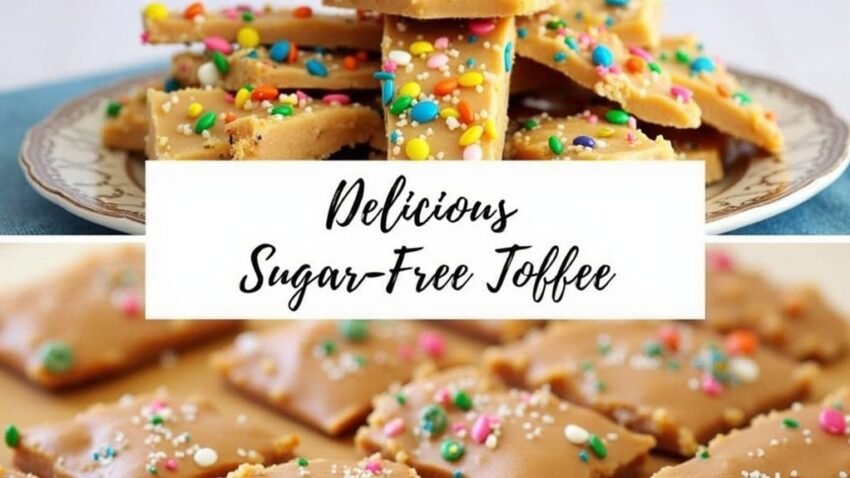Delicious Sugar-Free Toffee

Delicious Sugar-Free Toffee
You might think that toffee is off-limits if you’re cutting back on sugar, but sugar-free toffee challenges that notion. Crafted with unsalted butter and sweeteners, this treat provides a satisfying crunch without the guilt. Plus, it’s often improved with rich chocolate and nuts, making it not only delicious but potentially beneficial for your health. If you’re curious about how this delightful confection came to be and what simple ingredients you’ll need to make it, keep going—you might just find the perfect recipe for your next indulgence.
Key Takeaways
- Sugar-free toffee is made using unsalted butter, sugar-free sweetener, chocolate chips, and nuts for a delicious treat without added sugars.
- The recipe requires heating the mixture to hard crack stage (300°F) for the perfect crunchy texture.
- Experiment with different sugar-free sweeteners like allulose or erythritol to enhance flavor and texture.
- Dark chocolate with high cocoa content complements the toffee, providing richness without sugar.
- Store sugar-free toffee in an airtight container to maintain freshness for up to two weeks.
History
Toffee’s history dates back to the early 19th century, when it first captured the taste buds of many. It’s believed to have originated during this time, with the Oxford English Dictionary first mentioning the word “toffee” in 1825. The confection quickly gained popularity, mainly due to the abundance of sugar and butter available.
Key points about toffee’s early development include:
-
Preparation: Toffee is made by heating sugar and butter until caramelized, then cooling and hardening.
-
Name Origin: The term “toffee” may derive from the Hindi word “tāfī,” which refers to a similar sweet.
-
Traditional vs. Modern: Traditional English toffee typically omits nuts, while American variations often include them, particularly almonds or walnuts.
-
Culinary Innovators: George Bassett is credited with creating a unique toffee blend in 1817, which included nuts. This innovation contributed to the global diffusion of toffee through the British Empire.
As the British Empire expanded, toffee’s popularity spread globally.
Today, you can find toffee in various cultures, from British tea shops to Asian night markets. Its delightful mix of crunchy and creamy textures continues to enchant people, ensuring its place in confectionery history.
Recipe
Sugar-Free Toffee Recipe
Making sugar-free toffee is a delightful way to enjoy a sweet treat without the added sugar. This recipe combines rich flavors from unsalted butter and sugar-free sweeteners, resulting in a crunchy, satisfying texture that’s perfect for snacking or gifting. The addition of sugar-free chocolate and nuts enhances the toffee, making it an irresistible indulgence that fits into a low-carb lifestyle. This simple yet delicious recipe can be easily customized to suit your taste preferences.
To ensure the perfect texture, it’s essential to use the correct amount of sweetener, as the right amount of sweetener is crucial for texture; do not reduce. Whether you prefer a classic nut topping or want to experiment with different sugar-free sweeteners, the possibilities are endless. Follow the steps below to create your very own sugar-free toffee that you can savor guilt-free!
Ingredients:
– 1 cup unsalted butter
– 1 cup sugar-free sweetener (such as allulose, xylitol, or sucralose)
– 1 cup sugar-free chocolate chips
– 1 cup chopped almonds (or your choice of nuts)
– 1 teaspoon vanilla extract (optional)
– 1/2 teaspoon sea salt (optional)
Instructions:
Start by preheating your oven to 300°F (150°C) and lining a baking sheet or loaf pan with parchment paper.
In a medium saucepan, combine the unsalted butter and sugar-free sweetener, heating over medium heat while stirring until the sweetener is completely dissolved.
Continue to cook the mixture, using a candy thermometer to monitor the temperature, until it reaches the hard crack stage at 300°F.
Once the desired temperature is reached, remove the saucepan from the heat and allow it to cool slightly before pouring the mixture onto the prepared baking sheet.
Spread it out evenly, then melt the sugar-free chocolate in a separate bowl and pour it over the toffee.
Finally, sprinkle the chopped almonds on top and let the toffee set until solid.
Tips:
To guarantee your toffee turns out perfectly, using a candy thermometer is essential for monitoring the temperature accurately.
Be cautious not to overcook the mixture, as this can lead to a burnt flavor and undesirable texture.
Allow the toffee to cool slightly before pouring it onto the baking sheet to achieve that ideal crunchy consistency.
For storage, keep your toffee in an airtight container at room temperature to maintain freshness.
If you want to experiment, feel free to swap out nuts or sweeteners to create your perfect blend!
Final Thoughts
Enjoying sugar-free toffee not only satisfies your sweet tooth but also brings several health benefits to the table. This treat is particularly advantageous for those managing diabetes, as it has a lower impact on blood sugar levels. By avoiding traditional sugars, sugar-free toffee can help control carbohydrate intake and prevent significant spikes in blood glucose.
Additionally, sugar-free toffee promotes better dental health. Without sugars that feed harmful bacteria, you reduce the risk of tooth decay and cavities, making it a suitable option for both children and adults. Moreover, sugar-free sweeteners do not contribute to tooth decay, further supporting the health of your teeth.
From a general health perspective, sugar-free toffee serves as a healthier alternative to traditional candies. It can help minimize calorie intake, which is crucial for weight management, and offers a guilt-free indulgence for those looking to reduce sugar consumption.
When considering sugar-free toffee, it’s important to check the ingredients. Opt for products made with natural ingredients to avoid artificial additives. Always read labels carefully and consult with healthcare providers to confirm the choice aligns with your dietary needs.
FAQ
If you’re curious about sugar-free toffee, you might’ve some common questions. Here are a few frequently asked ones:
What ingredients do I need?
– Butter
– Allulose or another sugar-free sweetener
– Sugar-free chocolate chips
– Chopped nuts (like almonds or pecans)
– Sea salt and vanilla extract for flavor
Can I use different sweeteners?
– Yes! Allulose gives a smooth texture, while erythritol provides a crunch. You can also use brown sugar in some recipes if sugar isn’t a concern.
What kind of chocolate works best?
– Dark chocolate with high cocoa content or brands like Lily’s and ChocZero are excellent choices for sugar-free chocolate chips.
How long does it last?
– Store your sugar-free toffee in the fridge for up to two weeks or freeze it for up to three months.
Are there dietary benefits?
– This toffee is low in carbs, gluten-free, and contains no sugar, making it suitable for managing blood sugar levels while enjoying a treat. Additionally, using vertical lists in recipes can help organize complex information clearly.
With these answers, you can confidently create your delicious sugar-free toffee!
